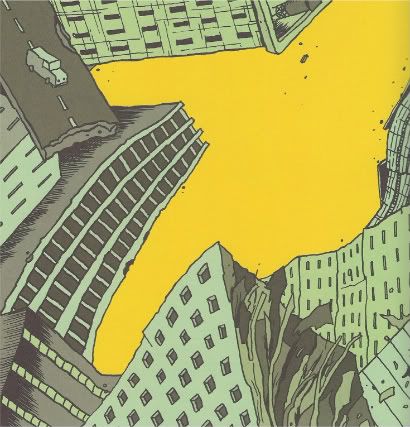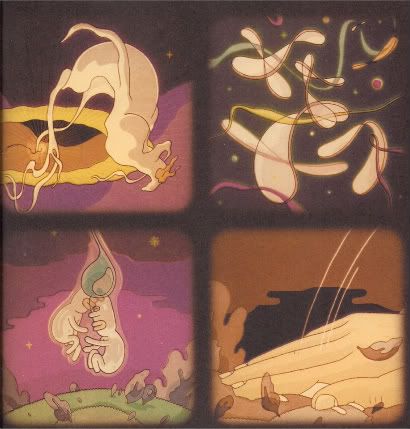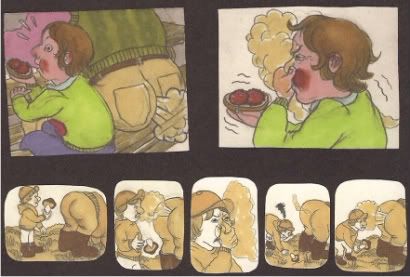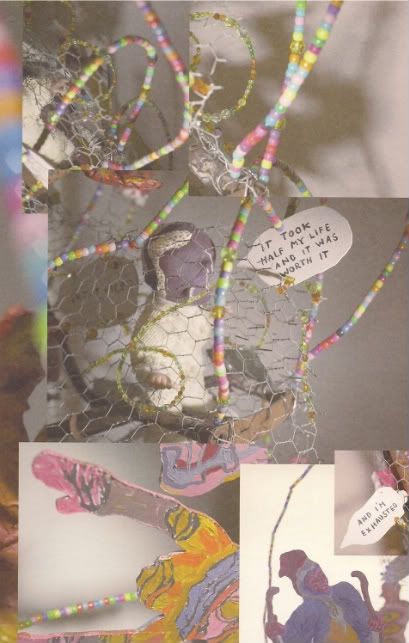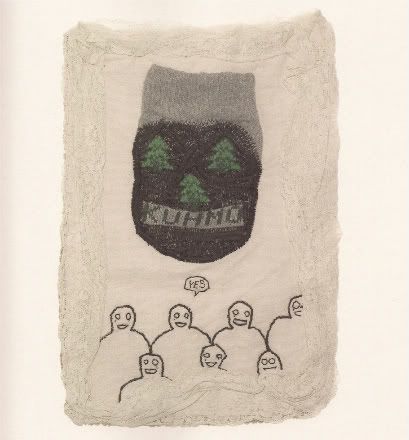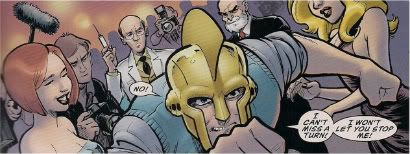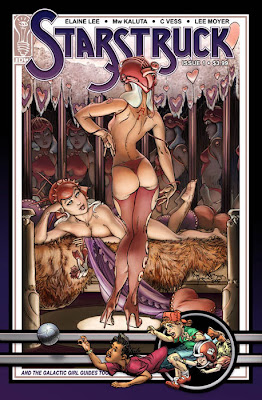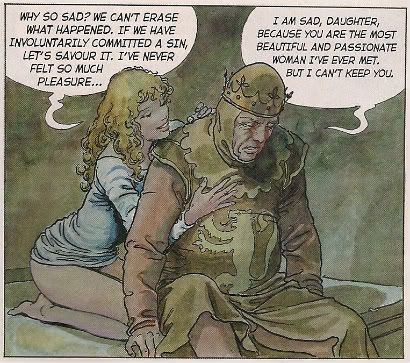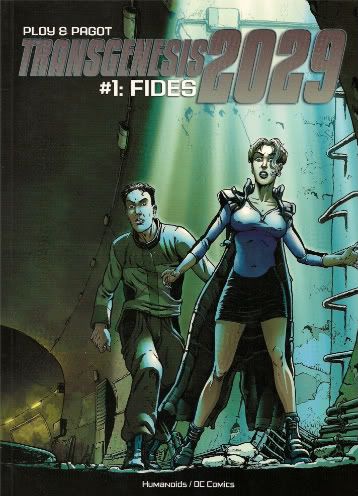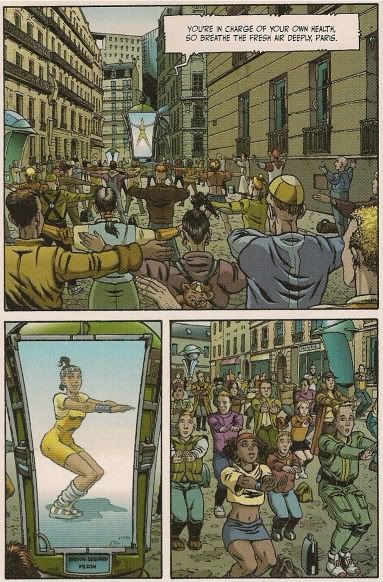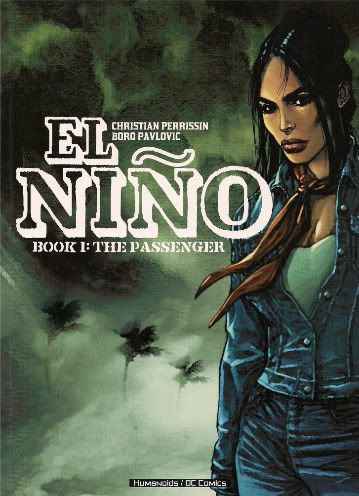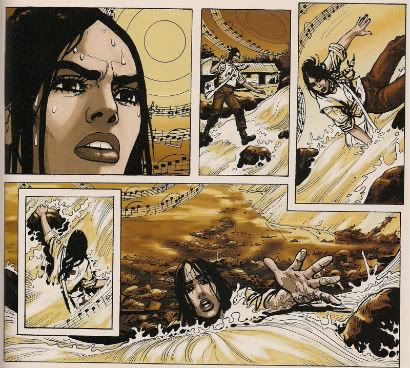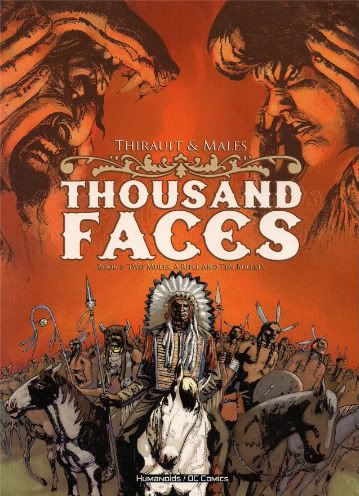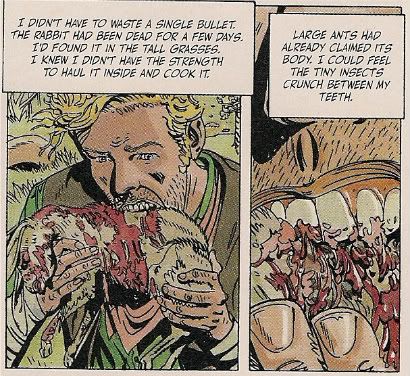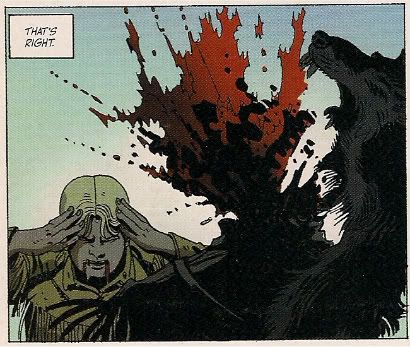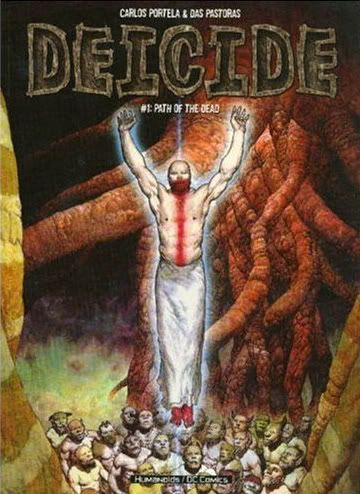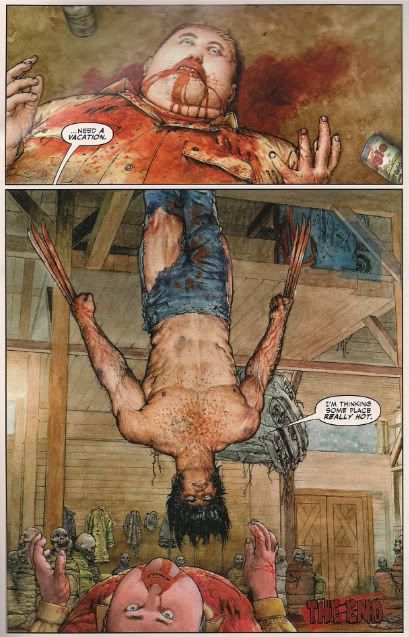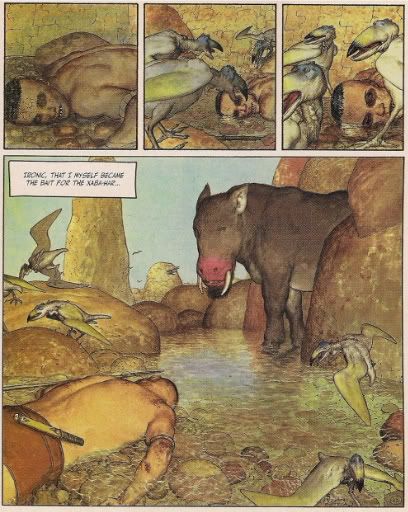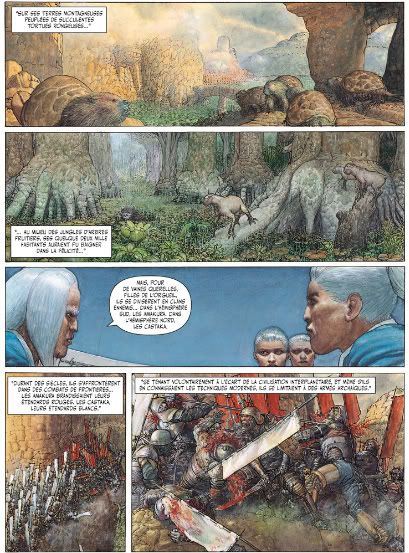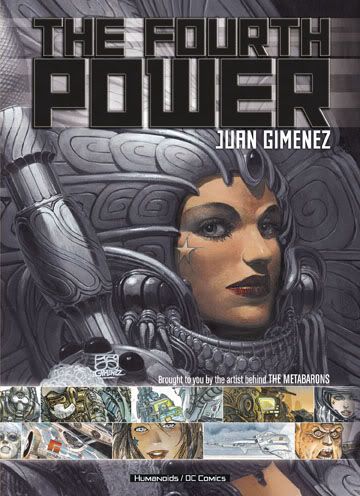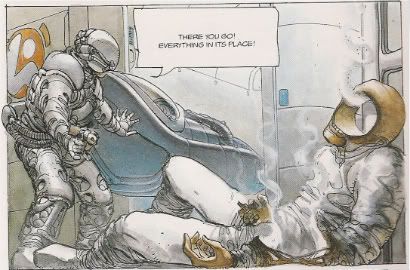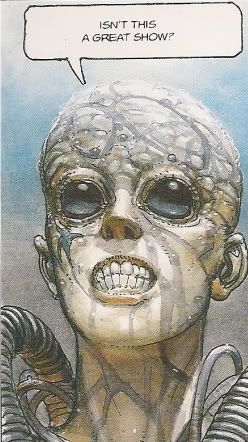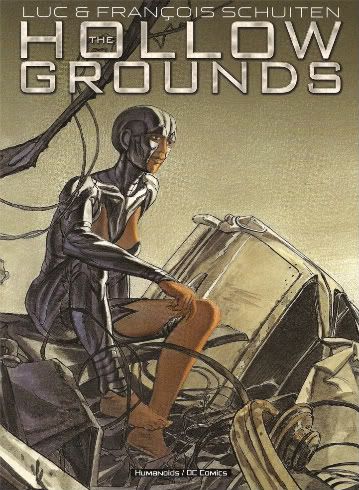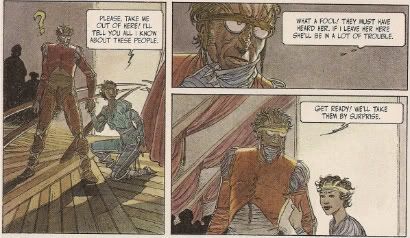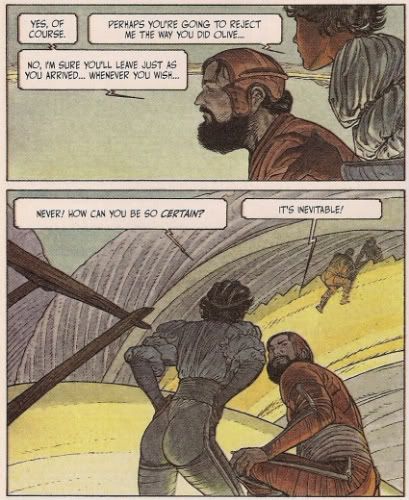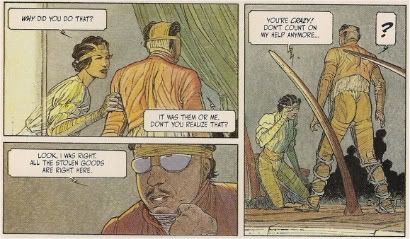I'm behind enough as it is.
*New comics on Thursday around here, which is why yesterday's Diamond-based post is today.
LAST WEEK'S REVIEWS:
GlömpX (all-Finland comics anthology, in English; three dimensional art to get you thinking about paper)
Plus!
Perramus: Escape From the Past (part one of a new series of not-too-long posts on foreign-language comics that somehow found their way to English back in the day; we begin with Alberto Breccia's omnivorous political allegory)
At The Savage Critics!
*Totally some stuff worth waiting for, though.
THIS WEEK IN COMICS!
Special Forces Vol. 1: Hot to Death: Sure, I'll say it: this is the best Kyle Baker comic of the 21st century so far, a spittin' mad satire of the Iraq War in the form of a breathtakingly crass action comics tribute to the struggles of America's most underprivileged troops that just can't help but romantizice the hell out of a situation none of these people should be in, all while dropping in tasty front-of-Previews comics industry bonuses like rampant sexualization of 'strong' female characters and entirely ill-fitting superhero-flavored tropes. Baker's visuals are a fascinating hybrid of his agile comedy style, contemporary post-Image impact and war comics classicism, and his Frank Miller-styled narrative voice is so dead-on eerie I've heard people swear it's Miller done right. I hope he keeps the original final page, 'cause it's like being slapped in the face. Only $16.99 for 200 big pages. The first two chapters are free online.
My Inner Bimbo: The newest work from Sam Kieth (with co-artists Josh Hagler & Leigh Dragoon), tracking the adventures of a aging man who's feminine aspect develops its own persona, eventually maturing into her own complicated person while still in limited control of Our Man's body. Magic, allusion and crypto-autobiography abound in dense, sooty pages. You know if you want it. From Oni; $19.95 for 168 b&w pages.
Chicken With Plums: A new softcover edition of Persepolis creator (and The Photographer guest letterer) Marjane Satrapi's most recent comic, an Angoulême Best Album winner concerning depression, music and food in 1950s Iran. From Pantheon; $12.95.
This is a Souvenir: The Songs of Spearmint & Shirley Lee: This certainly does appear to be a $29.99, 208-page all-color anthology of comics inspired by the British indie pop outfit. With contributions by Kieron Gillen & Jamie McKelvie, Chynna Clugston-Flores, Jamie S. Rich, Scott Mills, Rich Johnston, Salgood Sam and more. Edited by Eric Stephenson, and presented in the same massive LP size as the Tori Amos-themed Comic Book Tattoo, which should put it in the 'lavish' category as far as these things go. Gaze.
Bayou Vol. 1: Being the first hardcopy output of DC's Zuda label for webcomics; it's the first four chapters of Jeremy Love's story of fantasy creatures and child questing in a Depression Era deep south. The whole series is online here; the landscape-format book is $14.99 for 160 pages.
The John Stanley Library: Melvin Monster Vol. 1 (of 3): The official debut of Drawn and Quarterly's extensive, Seth-designed effort to compile the famed Little Lulu cartoonist's lesser-known works into deluxe 7.75" x 11" hardcovers; first up it's issues #1-3 of the 1965-69 Dell series about a creepy child who just wants to behave. Expect impeccable gags. It's 112 pages for $19.95. Sneak peek.
Edgar Rice Burroughs’ Tarzan: The Jesse Marsh Years Vol. 2: Another week, another Dark Horse Archives project, promising the Golden Age (and thereabouts, maybe) in hardcover for $49.95. This one sports issues #6-10 (1948-49) of the old Gold Key Tarzan series, from writer Gaylord DuBois and artist Jesse Marsh, the latter a sort of artist's artist's artist, admired by talents ranging from Alex Toth to Richard Corben to Gilbert Hernandez. For further reading, I commend to you Comic Art #9, and Ron Goulart's fine essay on the topic, but meanwhile there's 224 pages of color source material in here. Preview.
DC Comics Classics Library: Roots of the Swamp Thing: And moving forward in time, DC's all-color reprint brick effort brings us the first 13 issues (1972-74) of the original Len Wein-scripted muck monster ongoing (plus the origin stuff from House of Secrets #92), which I think should cover all of artist Bernie Wrightson's work on the series, along with a few issues of work by follow-up artist Nestor Redondo. Your $39.99 gets you 320 pages. Note that Wein's follow-up writer, Gerry Conway, has an all-new DC project starting this week, The Last Days of Animal Man #1 (of 6), a future-set story drawn by Chris Batista & Dave Meikis.
Elephantmen Vol. 2: Fatal Diseases: I'm gonna have to write more about this Richard Starkings-created Image series in the future, because it's genuinely odd work, an issue-by-issue modular perspective on vignettes from the ongoing lives of various people and anthropomorphic beasts trying to get by while massive socio-political operations click-clack around them, seemingly without anyone in power. It strikes me as reminiscent of a '90s self-publishing boom series, totally devoted to taking its author's playful ideas as seriously as possible across a longform narrative and often determinedly reaching beyond its grasp, although Elephantmen leaves open the possibility that the story will never end, barring some annihilation event. This is the second big hardcover collection of the main series, 312 color pages for $34.99, covering issues #8-14, plus the 'pilot' issue of preliminary concepts by Kurt Busiek, Jeph Loeb and others.
Berserk Vol. 29: Will Kentaro Miura's grue-smeared anti-fantasy manga ever come to an end? Um, I don't really know; didn't he say this was supposed to be his life's work or something? Hey, witches. It's 216 pages for $13.95. Also in swords this week, note that Dark Horse has the $17.95 softcover collection Conan Vol. 7: Cimmeria, which picks up all of Richard Corben's recent work on the series, albeit as flashbacks within a larger tale from writer Tim Truman and primary artist Tomás Giorello.
20th Century Boys Vol. 2 (of 24): I'm telling ya - two volumes in, and this is already my favorite Naoki Urasawa series. A rash decision? Perhaps; 4000+ pages to go leaves plenty of room to mess things up. But right now? It's Urasawa's warmest, most character-driven work by far, which I admit may try the patience of folks who want a smoking suspense juggernaut right off the top, but again: 4000+ pages.
Madame Xanadu #11: In which series writer Matt Wagner kicks off a five-issue storyline featuring art by Michael Wm. Kaluta, working on comics interiors for the first time since... I think he illustrated an Alan Moore prose thing in Tom Strong's Terrific Tales #9 in '04? Before that you might have to hit those Dark Horse The Shadow comics from the '90s. Anyhow, here he is.
Garth Ennis' Battlefields: The Tankies #2 (of 3): More treading from Ennis & artist Carlos Ezquerra. Have a look, and keep another eye peeled for Dynamite's $12.99 softcover collection of the series' prior war story, Dear Billy, drawn by the often underrated Peter Snejbjerg.
Gødland #28: Always good to have a little Joe Casey & Tom Scioli. Preview.
glamourpuss #7: Dave Sim, on schedule.
Ignition City #3 (of 5): Warren Ellis and people that don't blast off.
Crossed #5 (of 9): If this was a movie at Cannes this year, I bet it'd have won some shit.
God of Comics: Osamu Tezuka and the Creation of Post-World War II Manga: I'll presume this isn't the first academic study of Dr. Tezuka's oeuvre ever published in English, but it's the only one I can think of at the moment. Author Natsu Onoda Power promises an emphasis on Tezuka's use of intertextuality -- concerning both his own creations and various non-comics works -- and close readings of some obscure, never-published-in-English pieces. From the University Press of Mississippi, a 208-page softcover priced at $25.00.
LAST WEEK'S REVIEWS:
GlömpX (all-Finland comics anthology, in English; three dimensional art to get you thinking about paper)
Plus!
Perramus: Escape From the Past (part one of a new series of not-too-long posts on foreign-language comics that somehow found their way to English back in the day; we begin with Alberto Breccia's omnivorous political allegory)
At The Savage Critics!
*Totally some stuff worth waiting for, though.
THIS WEEK IN COMICS!
Special Forces Vol. 1: Hot to Death: Sure, I'll say it: this is the best Kyle Baker comic of the 21st century so far, a spittin' mad satire of the Iraq War in the form of a breathtakingly crass action comics tribute to the struggles of America's most underprivileged troops that just can't help but romantizice the hell out of a situation none of these people should be in, all while dropping in tasty front-of-Previews comics industry bonuses like rampant sexualization of 'strong' female characters and entirely ill-fitting superhero-flavored tropes. Baker's visuals are a fascinating hybrid of his agile comedy style, contemporary post-Image impact and war comics classicism, and his Frank Miller-styled narrative voice is so dead-on eerie I've heard people swear it's Miller done right. I hope he keeps the original final page, 'cause it's like being slapped in the face. Only $16.99 for 200 big pages. The first two chapters are free online.
My Inner Bimbo: The newest work from Sam Kieth (with co-artists Josh Hagler & Leigh Dragoon), tracking the adventures of a aging man who's feminine aspect develops its own persona, eventually maturing into her own complicated person while still in limited control of Our Man's body. Magic, allusion and crypto-autobiography abound in dense, sooty pages. You know if you want it. From Oni; $19.95 for 168 b&w pages.
Chicken With Plums: A new softcover edition of Persepolis creator (and The Photographer guest letterer) Marjane Satrapi's most recent comic, an Angoulême Best Album winner concerning depression, music and food in 1950s Iran. From Pantheon; $12.95.
This is a Souvenir: The Songs of Spearmint & Shirley Lee: This certainly does appear to be a $29.99, 208-page all-color anthology of comics inspired by the British indie pop outfit. With contributions by Kieron Gillen & Jamie McKelvie, Chynna Clugston-Flores, Jamie S. Rich, Scott Mills, Rich Johnston, Salgood Sam and more. Edited by Eric Stephenson, and presented in the same massive LP size as the Tori Amos-themed Comic Book Tattoo, which should put it in the 'lavish' category as far as these things go. Gaze.
Bayou Vol. 1: Being the first hardcopy output of DC's Zuda label for webcomics; it's the first four chapters of Jeremy Love's story of fantasy creatures and child questing in a Depression Era deep south. The whole series is online here; the landscape-format book is $14.99 for 160 pages.
The John Stanley Library: Melvin Monster Vol. 1 (of 3): The official debut of Drawn and Quarterly's extensive, Seth-designed effort to compile the famed Little Lulu cartoonist's lesser-known works into deluxe 7.75" x 11" hardcovers; first up it's issues #1-3 of the 1965-69 Dell series about a creepy child who just wants to behave. Expect impeccable gags. It's 112 pages for $19.95. Sneak peek.
Edgar Rice Burroughs’ Tarzan: The Jesse Marsh Years Vol. 2: Another week, another Dark Horse Archives project, promising the Golden Age (and thereabouts, maybe) in hardcover for $49.95. This one sports issues #6-10 (1948-49) of the old Gold Key Tarzan series, from writer Gaylord DuBois and artist Jesse Marsh, the latter a sort of artist's artist's artist, admired by talents ranging from Alex Toth to Richard Corben to Gilbert Hernandez. For further reading, I commend to you Comic Art #9, and Ron Goulart's fine essay on the topic, but meanwhile there's 224 pages of color source material in here. Preview.
DC Comics Classics Library: Roots of the Swamp Thing: And moving forward in time, DC's all-color reprint brick effort brings us the first 13 issues (1972-74) of the original Len Wein-scripted muck monster ongoing (plus the origin stuff from House of Secrets #92), which I think should cover all of artist Bernie Wrightson's work on the series, along with a few issues of work by follow-up artist Nestor Redondo. Your $39.99 gets you 320 pages. Note that Wein's follow-up writer, Gerry Conway, has an all-new DC project starting this week, The Last Days of Animal Man #1 (of 6), a future-set story drawn by Chris Batista & Dave Meikis.
Elephantmen Vol. 2: Fatal Diseases: I'm gonna have to write more about this Richard Starkings-created Image series in the future, because it's genuinely odd work, an issue-by-issue modular perspective on vignettes from the ongoing lives of various people and anthropomorphic beasts trying to get by while massive socio-political operations click-clack around them, seemingly without anyone in power. It strikes me as reminiscent of a '90s self-publishing boom series, totally devoted to taking its author's playful ideas as seriously as possible across a longform narrative and often determinedly reaching beyond its grasp, although Elephantmen leaves open the possibility that the story will never end, barring some annihilation event. This is the second big hardcover collection of the main series, 312 color pages for $34.99, covering issues #8-14, plus the 'pilot' issue of preliminary concepts by Kurt Busiek, Jeph Loeb and others.
Berserk Vol. 29: Will Kentaro Miura's grue-smeared anti-fantasy manga ever come to an end? Um, I don't really know; didn't he say this was supposed to be his life's work or something? Hey, witches. It's 216 pages for $13.95. Also in swords this week, note that Dark Horse has the $17.95 softcover collection Conan Vol. 7: Cimmeria, which picks up all of Richard Corben's recent work on the series, albeit as flashbacks within a larger tale from writer Tim Truman and primary artist Tomás Giorello.
20th Century Boys Vol. 2 (of 24): I'm telling ya - two volumes in, and this is already my favorite Naoki Urasawa series. A rash decision? Perhaps; 4000+ pages to go leaves plenty of room to mess things up. But right now? It's Urasawa's warmest, most character-driven work by far, which I admit may try the patience of folks who want a smoking suspense juggernaut right off the top, but again: 4000+ pages.
Madame Xanadu #11: In which series writer Matt Wagner kicks off a five-issue storyline featuring art by Michael Wm. Kaluta, working on comics interiors for the first time since... I think he illustrated an Alan Moore prose thing in Tom Strong's Terrific Tales #9 in '04? Before that you might have to hit those Dark Horse The Shadow comics from the '90s. Anyhow, here he is.
Garth Ennis' Battlefields: The Tankies #2 (of 3): More treading from Ennis & artist Carlos Ezquerra. Have a look, and keep another eye peeled for Dynamite's $12.99 softcover collection of the series' prior war story, Dear Billy, drawn by the often underrated Peter Snejbjerg.
Gødland #28: Always good to have a little Joe Casey & Tom Scioli. Preview.
glamourpuss #7: Dave Sim, on schedule.
Ignition City #3 (of 5): Warren Ellis and people that don't blast off.
Crossed #5 (of 9): If this was a movie at Cannes this year, I bet it'd have won some shit.
God of Comics: Osamu Tezuka and the Creation of Post-World War II Manga: I'll presume this isn't the first academic study of Dr. Tezuka's oeuvre ever published in English, but it's the only one I can think of at the moment. Author Natsu Onoda Power promises an emphasis on Tezuka's use of intertextuality -- concerning both his own creations and various non-comics works -- and close readings of some obscure, never-published-in-English pieces. From the University Press of Mississippi, a 208-page softcover priced at $25.00.
Labels: this week in comics

